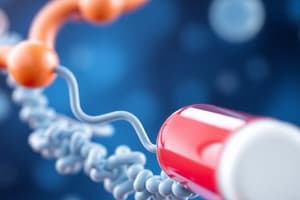Podcast
Questions and Answers
What is the primary role of the pyloric sphincter?
What is the primary role of the pyloric sphincter?
- To produce mucus to protect the stomach lining.
- To absorb nutrients from the small intestine.
- To secrete digestive enzymes into the stomach.
- To control the flow of chyme from the stomach to the small intestine. (correct)
Which of the following factors is least likely to affect the rate of drug absorption in the small intestine?
Which of the following factors is least likely to affect the rate of drug absorption in the small intestine?
- The presence of luminal enzymes.
- The presence of food in the gastrointestinal tract.
- The molecular weight of the drug. (correct)
- The pH of the intestinal contents.
Which of the following characteristics is not typically associated with passive diffusion of drugs across the GI membrane?
Which of the following characteristics is not typically associated with passive diffusion of drugs across the GI membrane?
- It is the most common mechanism for drug absorption.
- It does not require energy expenditure by the cells.
- It is driven by a concentration gradient.
- It is a saturable process. (correct)
Under what conditions are 'sink conditions' maintained during drug absorption via diffusion across the GI membrane?
Under what conditions are 'sink conditions' maintained during drug absorption via diffusion across the GI membrane?
Which of the following statements accurately describes the relationship between gastric residence time and the size of a dosage form?
Which of the following statements accurately describes the relationship between gastric residence time and the size of a dosage form?
Which of the following factors is most likely to affect the ability of drugs to be absorbed in the colon?
Which of the following factors is most likely to affect the ability of drugs to be absorbed in the colon?
How can gastrointestinal pH affect drug absorption?
How can gastrointestinal pH affect drug absorption?
Which of the following statements accurately describes active transport of drugs across the GI membrane?
Which of the following statements accurately describes active transport of drugs across the GI membrane?
Flashcards
Oral route advantages
Oral route advantages
The benefits of administering drugs orally, including ease of use and patient compliance.
GI mucus
GI mucus
A protective layer in the gastrointestinal epithelium that aids in digestion and absorption.
Stomach functions
Stomach functions
The stomach's roles include digestion, secretion of gastric juices, and varying pH based on fed or fasting states.
Gastric motility
Gastric motility
Signup and view all the flashcards
Gastric residence time
Gastric residence time
Signup and view all the flashcards
Drug absorption barriers
Drug absorption barriers
Signup and view all the flashcards
GI membrane transport
GI membrane transport
Signup and view all the flashcards
Active transport
Active transport
Signup and view all the flashcards
Study Notes
Biopharmaceutics Part A - Specific Aims
- Oral administration advantages
- Gastrointestinal (GI) tract components and function
- Mucus: roles, components, turnover time
- Stomach: volumes (fed/fasting), pH, secretions, motility patterns, pyloric sphincter role, MMC phase III location
- Small intestine: roles, length, pH, absorption factors
- Colon: roles, length, pH, absorption factors
- Drug gastric residence time
- Factors affecting residence time: dosage form size, meal, administration with water vs. food
- Transit times: small and large intestines
- Barriers to drug absorption
- GI lumen and unstirred water layer
- Gastrointestinal pH, food (including grapefruit juice), disease states, and luminal enzymes
- Drug transport across GI membrane
- Membrane characteristics
- Passive diffusion: factors affecting rate, sink condition maintenance, drug concentration in blood vs. GI fluids
- Active transport: carrier-mediated, energy investment, saturability, relevant molecules, multiple transport mechanisms
- Facilitated diffusion: importance for drug absorption
- Endocytosis: major types
- Paracellular pathway: types of drugs using this mechanism
- Drug efflux in the intestine
- Main protein in small intestine
- Efflux impact on bioavailability
- Review questions
Studying That Suits You
Use AI to generate personalized quizzes and flashcards to suit your learning preferences.




